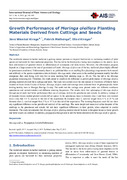Growth Performance of Moringa oleifera Planting Materials Derived from Cuttings and Seeds
Abstract
The worldwide interest in herbal medicine is putting intense pressure on tropical biodiversity as increasing numbers of plant species are harvested for their medicinal properties. This has led to the forest policy laying more emphasis on the need to move
from reforestation of gazetted forests to afforestation of community and farm forests. However, the afforestation program
depends to a large extent on the rate of germination of seeds. Moringa oleifera one of the key medicinal plants highly affected
by germination conditions. Unfortunately, there is no published data on its seedling Eco-physiology (regeneration both natural and artificial) or the species exploitation rates in Kenya. Moringa seeds, when sown in the seedbed germinate readily, but after
emergence, they start dying, with very few or none reaching field planting stage i.e. 30 cm. This has led to the Moringa
population remaining low. Therefore, this study aimed to establish the difference in growth performance of Moringa oleifera
planting materials derived from cuttings and seeds. The study was carried out at the tree nursery at University of Eldoret that is situated in Uasin Gishu County of Kenya. Moringa oleifera seeds and cuttings were collected from 30 phenotypically better looking healthy trees in Marigat, Baringo County. The seeds and the cuttings were planted under two different conditions (greenhouse and normal/outside) and different watering frequencies. The results show that upbringing of Moringa oleifera
through use of seeds had better performance than use of cuttings, both in the greenhouse and outside. In addition, cuttings of all diameter classes studied planted outside did not sprout. In the greenhouse, those in diameter class 1 and those only watered twice a day had 5.8 % survival at the end of the experiment. In diameter class 2, survival ranged from 5 % to 35 % and diameter class 3, survival ranged from 5 % to 15 % at the end of the experiment. The watering frequency used did not show
any significant difference in the growth and survival of the seedlings. The mean height and mean root collar diameter of the
seedlings in the greenhouse and outside did not show significant differences in their growth, when subjected to similar treatments. The study recommends that Moringa oleifera planting material should be done in the green house as faster growth
and better results are realized. In addition, propagation through seed is still the better alternative for Moringa oleifera species.
